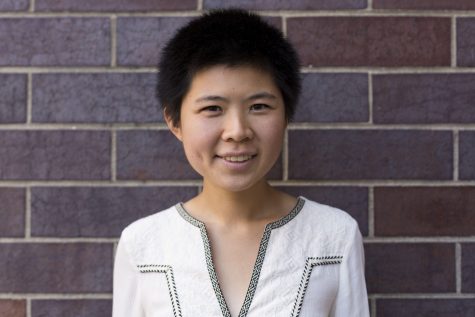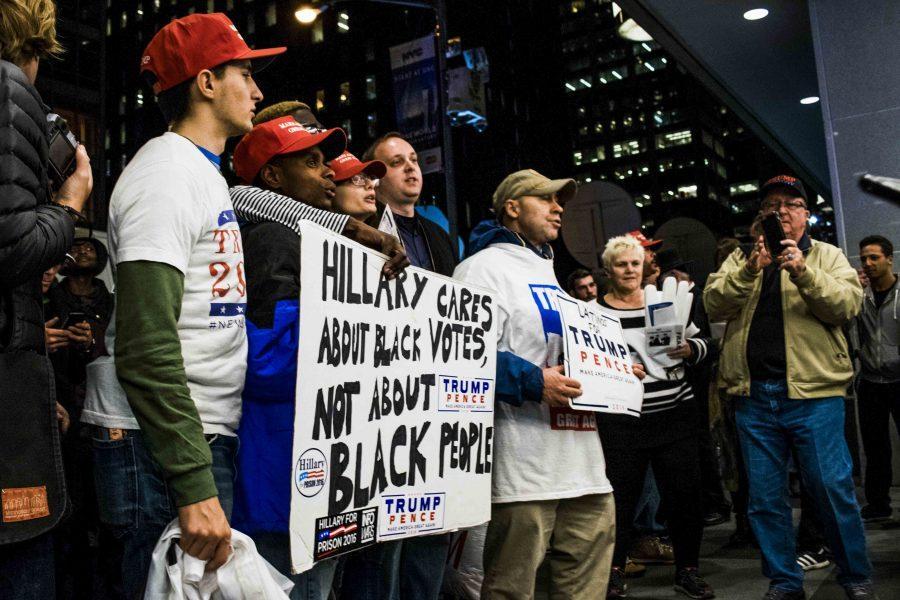How Did We Get These Candidates?
Trump supporters outside of the Hilton on the night of the Election with posters against Hillary.
There has never and will never be another election quite like the 2016 presidential race. Russell Hardin, a Professor of Politics and Helen Gould Shepard Professor in the Social Sciences at NYU, specializes in rational choice as well as moral and political philosophy. Hardin sat down with WSN to discuss this election and analyze how the nation chose a non-political Republican nominee and the first female nominee at the Democratic helm.
Donald Trump
From ABC to Business Insider, people scoffed at the notion of a Donald Trump nomination when he announced his candidacy way back in June 2015. And yet, the businessman managed to pull out an unlikely victory on Tuesday. Hardin said that because of so much original backlash, many people wondered how Trump received the nomination during the Republican National Convention in August 2016.
“I think it was a very straightforward deal,” Hardin said. “There are a couple factors that are hard to figure, but one of them is there weren’t many strong candidates on the side of the Republicans — that’s unusual.”
He said that the Republicans normally present a politically strong candidate who competes equally with the Democratic nominee.
“Candidates tore each other down and were fairly successful at that,” Hardin said. “Even though these people were not strong to begin with, they were even weaker as the campaign season went on, and that’s a kind of world in which you don’t want to be
a participant.”
The weakened field may have been a stroke of good luck for Trump, who is an outsider to the political world, giving him a chance to come out looking strong in the election pool. Hardin said that this serendipitous timing for Trump is often overlooked by people when they tried to see how the country reached a Trump presidency.
The Trump victory, Hardin speculated, was likely conflicting for many Republican voters when looking at the party’s trajectory for the past 10 years.
“It’s hard for a Republican looking to vote in that particular election,” Hardin said. “But it’s hard to analyze also those who are liberal and would love to continue the liberal tradition that was established by the last decade or so, and it looks hard to do at the moment. We can’t really say what’s going to happen.”
Trump’s rhetoric will only be magnified and legitimized following election day, so the future of this outside-the-establishment figure remains a very real — and now attainable — goal for American voters on both parties.
Trump was obviously not afraid to speak his mind during the election cycle, and many voters liked that he was not afraid to call out the problems of the United States — even if he didn’t always provide viable solutions. With his motto “Make America Great Again,” Trump played to the fears of many conservative Americans, especially those who have felt disenfranchised as the country has shifted further and further left.
With a surface understanding of international issues and proposing idealistic far-right immigration policies, Trump appealed to a voiceless demographic and was seen as the solution for problems that scared so many Americans.
“All of that is the growth of populism with Trump as the arbiter of that position,” Hardin said. “Trump is from the outside, and you couldn’t even begin to explain his conservatism or his means as an entertainer or whatever they call him.”
The reverence of Trump also may have given him advantages that other candidates were not able to obtain.
“He didn’t face the usual kinds of problems in mobilizing a candidacy,” Hardin said. “Some people just expected him to lose, but he kept gaining more and more popularity as time went on.”
Hillary Clinton
“It’s been an odd year,” Hardin said. “In fact, if you have looked at standard explanations and models and electoral contests, this one would not fit. So it’s strange what’s going on and strange in a way to people as well.”
Hardin stated that despite the unprecedented political realm, this election has coincided with the best economy since 1936 and relatively stable international relations. So, how did we end up with the Clinton vs. Trump showdown?
Hillary Clinton narrowly missed winning the election on Tuesday night. But even before Tuesday, Clinton’s nomination was historic — she was the first female to receive a nomination from a major party.
Her campaign highlighted the female power with the hashtag #ImWithHer, and Clinton’s rhetoric throughout the election trail discussed the glass ceiling for women trying to succeed in a male-dominated society and the struggles they face every single day.
Hardin said that although historic, Clinton representing the party was a natural progression and fairly straightforward since she fits the typical politician role — including her discussion of the aforementioned civil rights. However, he added that her nomination signified a change within the American viewpoints regarding feminism, especially compared to countries around
the world.
“She was pretty well guaranteed at a probably very early stage [of the nomination],” Hardin said. “And if there was a hesitation, it was a hesitation from anti-feminists who thought that she was not
strong enough.”
He said that feminism in the United States is a considerably weaker movement considering the population of feminists in America compared to that of other countries. Even now, some people qualify her nomination by saying that Clinton only received the nomination through the good fortune that other, more qualified candidates — such as Vice President Joe Biden — did not enter the race.
This debate of women’s place within politics dates back to 1848 with the Seneca Falls Convention, which kickstarted the conversation surrounding women’s voting rights.
The Women’s Suffrage Movement was led by people such as Susan B. Anthony and Elizabeth Cady Stanton, but both passed away before their efforts came to fruition with the ratification of the 19th Amendment in 1920. Because of Clinton’s position on the ballot, many women put their “I Voted” stickers on Anthony’s gravestone on Tuesday to pay tribute to her.
And in light of the rhetoric by Trump, such as his April 16 tweet that speculated, “If Hillary Clinton can’t satisfy her husband what makes her think she can satisfy America?” FiveThirtyEight released a map to demonstrate just how gendered this presidential election is.
The news outlet made two maps that showed what the election results would be if only women voted versus the election results if only men voted. Unsurprisingly, a women-only election would give Clinton a landslide victory, while men largely favored Trump. This started the #repealthe19th movement on various social media platforms, and memes even started appearing in support of the trending topic.
Hardin said that this male-female dichotomy is not as prevalent in other countries and that in the United Kingdom, the Labor Party was deciding between two female candidates. He said that the U.K. touts a history of female domination in its politics and that it would have been nice to see that in the United States.
He added that Clinton has a successful and unique series of positions within the political world, and the presidency would have been a logical most recent addition to the list.
“Around the world, we have strong women leaders in many countries such as Germany,” Hardin said. “Clinton is in fact quite strong — has been quite strong.”
A version of this article appeared in the WSN 2016 Election Issue. Email Diamond Naga Siu at [email protected].

Diamond Naga Siu is the News Editor for the Washington Square News and is a sophomore studying Journalism and Educational Human Rights in Gallatin. When...

























































































































































